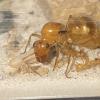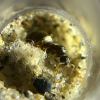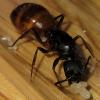- Formiculture.com
- Forums
- Gallery
- Members
- Member Map
- Chat

Southern California Anting
Started By
dspdrew
, Mar 6 2015 5:57 PM
2474 replies to this topic
#2421
 Online
-
Posted December 22 2023 - 1:38 PM
Online
-
Posted December 22 2023 - 1:38 PM
That’s really cool.
- 100lols likes this
"The ants are a people not strong, yet they prepare their meat in the summer." Prov. 30:25
Keep ordinary ants in extraordinary ways.
Keep ordinary ants in extraordinary ways.
#2423
 Offline
-
Posted December 22 2023 - 8:11 PM
Offline
-
Posted December 22 2023 - 8:11 PM
Oh wow good pictures. Was that the 74?
- 100lols likes this
#2424
 Offline
-
Posted December 23 2023 - 10:46 AM
Offline
-
Posted December 23 2023 - 10:46 AM
We were off of Montezuma Valley Rd(the S22). It’s a fun drive!Oh wow good pictures. Was that the 74?
Edited by 100lols, December 23 2023 - 10:46 AM.
#2425
 Offline
-
Posted December 29 2023 - 12:26 PM
Offline
-
Posted December 29 2023 - 12:26 PM
I'm going to in LA this week, Is anything flying in california at this time?
#2426
 Offline
-
Posted December 29 2023 - 2:13 PM
Offline
-
Posted December 29 2023 - 2:13 PM
Not this time of the year.
- 100lols likes this
#2427
 Offline
-
Posted December 29 2023 - 4:27 PM
Offline
-
Posted December 29 2023 - 4:27 PM
Makes sense, thanks!Not this time of the year.
#2428
 Offline
-
Posted February 4 2024 - 7:03 PM
Offline
-
Posted February 4 2024 - 7:03 PM
I purchased a black light around September of last year and even though I used it late in the season, I still was able to attracts a lot of solenopsis males and females. However they just seemed to walk and fly around the light withought actually mating. I caught a couple of the females and put them in test tubes. A few shedded wings, but none ended up laying eggs. Does anyone know why none of the queens were mating, or if I was somehow using the light wrong?
#2429
 Offline
-
Posted February 4 2024 - 7:37 PM
Offline
-
Posted February 4 2024 - 7:37 PM
What if there were different types of males/females?
#2430
 Offline
-
Posted February 4 2024 - 8:11 PM
Offline
-
Posted February 4 2024 - 8:11 PM
I purchased a black light around September of last year and even though I used it late in the season, I still was able to attracts a lot of solenopsis males and females. However they just seemed to walk and fly around the light withought actually mating. I caught a couple of the females and put them in test tubes. A few shedded wings, but none ended up laying eggs. Does anyone know why none of the queens were mating, or if I was somehow using the light wrong?
The light doesn't make them mate. It just attracts them.
#2431
 Offline
-
Posted February 4 2024 - 8:19 PM
Offline
-
Posted February 4 2024 - 8:19 PM
Definitely saw males and females of the same speciesWhat if there were different types of males/females?
I purchased a black light around September of last year and even though I used it late in the season, I still was able to attracts a lot of solenopsis males and females. However they just seemed to walk and fly around the light withought actually mating. I caught a couple of the females and put them in test tubes. A few shedded wings, but none ended up laying eggs. Does anyone know why none of the queens were mating, or if I was somehow using the light wrong?
The light doesn't make them mate. It just attracts them.
I know that, but based on what I saw online they were attracted to the light and because they were in close proximity they mated. Kinda like a synthetic nuptial flight.
#2432
 Offline
-
Posted February 4 2024 - 8:44 PM
Offline
-
Posted February 4 2024 - 8:44 PM
I'm interested in how you confirmed that both the gynes and males were of the same species. In my area, there's three different S. molesta-group species and it's not uncommon to get gynes of one and males of another at the same time.
- gcsnelling likes this
#2433
 Offline
-
Posted February 4 2024 - 9:13 PM
Offline
-
Posted February 4 2024 - 9:13 PM
To be honest, I just looked up pictures of S. molesta and saw that the males and females at my black light looked exactly like the species online, however you could be totally correct.
In addition to molesta there were also males and females of Tapinoma sessile at the light. I am sure that they were of the same species because I saw multiple colonies in my yard that were having nuptial flights and were being attracted to the light. They also just grouped around the light and didn’t end up mating like the molesta.
In addition to molesta there were also males and females of Tapinoma sessile at the light. I am sure that they were of the same species because I saw multiple colonies in my yard that were having nuptial flights and were being attracted to the light. They also just grouped around the light and didn’t end up mating like the molesta.
#2434
 Offline
-
Posted February 4 2024 - 9:17 PM
Offline
-
Posted February 4 2024 - 9:17 PM
It's worth noting that S. molesta-group males can be nearly indistinguishable from each other, especially accounting for how many undescribed "Diplorhoptrum" Solenopsis occur here.
- gcsnelling likes this
#2435
 Offline
-
Posted February 11 2024 - 4:32 PM
Offline
-
Posted February 11 2024 - 4:32 PM
Here's a little trip through a Joshua tree forest out near Nipton, California last season after a storm went through earlier.
Same road at night, many miles out, passing some of the biggest Joshua trees I've seen.
Nipton Road at dusk in the same area.
- gcsnelling likes this
#2436
 Offline
-
Posted February 11 2024 - 5:04 PM
Offline
-
Posted February 11 2024 - 5:04 PM
any queens?
Edited by AsdinAnts, February 11 2024 - 5:05 PM.
#2437
 Offline
-
Posted February 12 2024 - 3:49 PM
Offline
-
Posted February 12 2024 - 3:49 PM
any queens?
Got plenty of them that year.
#2438
 Offline
-
Posted February 16 2024 - 7:55 PM
Offline
-
Posted February 16 2024 - 7:55 PM
Anyone know the conditions spring Camponotus need to fly? Caught lots last year in San Diego in April (vicinus, ca-02, etc). Wish I recorded the weather...
Interested buying in ants? Feel free to check out my shop!
Feel free to read my journals, like this one.
Wishlist:
Atta sp (wish they were in CA), Crematogaster cerasi, Most Pheidole species
#2439
 Offline
-
Posted February 16 2024 - 8:26 PM
Offline
-
Posted February 16 2024 - 8:26 PM
2 user(s) are reading this topic
0 members, 2 guests, 0 anonymous users





















